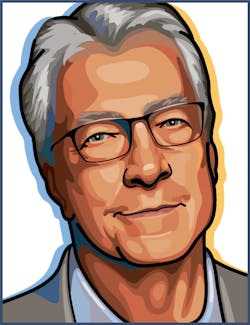Next-generation industrial laser systems compete for European laser prize

The Innovation Award Laser Technology 2014 prize of 10,000 euros will be awarded during AKL'14 to one of three finalists announced by the Arbeitskreis Lasertechnik e.V. and the European Laser Institute ELI. The finalists are all worthy of note for their work, but even more so for the trends in industrial laser materials processing that they reveal:
- A femtosecond laser printer for three-dimensional micro- and nano-manufacturing of glass—from a team represented by Dr. Yves Bellouard from Eindhoven University of Technology
- The measurement of penetration depth and topography in laser materials processing using low coherence interferometry--from a team represented by Dr. Markus Kogel-Hollacher at Precitec Optronik
- Laser fired contact technology for producing highly efficient silicon solar cells—from a team represented by Dr. Ralf Preu at the Fraunhofer Institute for Solar Energy Systems ISE
AKL'14, organized by the Fraunhofer ILT, will be held May 7-9, in Aachen, Germany. For more information on the prize, visit the website: http://www.innovation-award-laser.org/akl-ev.html
Here is more on the three laser technology finalists:
1. Femtoprint: A femtosecond laser printer for three-dimensional micro- and nano-manufacturing of glass
Team representative: Dr. Yves Bellouard, with members from Amplitude Systèmes, Mecartex SA, Quintenz Hybridtechnik, CSEM , University of Southampton, EPFL, ALPhANOV, and FEMTOprint.
Over the last three years a prototype of a desktop Femtoprinter suitable for micro-/nanomanufacturing of glass has been developed. It can provide affordable and on-site microsystems production capabilities to a large community of users. The Femtoprinter combines in a desktop system, advanced femtosecond laser technologies with 3D precision positioning mechanism, coupled through in-depth process engineering. This prototype is now commercialized by FEMTOprint SA, a spin-off of the European project. Highlighted applications realized in the project were the first demonstration of algae biochips, first transparent actuators, novel polarization converters to create optical vortices, new moulding processes, and the demonstration of 5D optical memory.
Related article: Laser Additive Manufacturing: How does additive manufacturing 'stack up' against subtractive methods?
Related article: Laser processing of glass has high growth potential
2. Penetration depth and topography measurement in laser materials processing using low coherence interferometry
Team representative Dr. Markus Kogel-Hollacher, with members from Precitec Optronik, Scheidt & Bachmann, and Fraunhofer IPT.
In online quality assurance of laser processing there are still unsolved tasks, including the online measurement of the penetration depth during laser welding. This innovation is the development of a new online sensor technology on the basis of low coherence interferometry, which is capable of exactly measuring the depth of the keyhole during laser welding, the amount of ablated material during laser structuring, or the level of material build up during additive manufacturing. Low coherence light is used with an interferometer for distance measurement of scattering materials like human tissue. In September 2013 a commercial system called In-Process Depth Meter (IDM) was released, and so far shows an accuracy of the measured depth value of better than ± 10 microns.
Related article: Laser-based material processing to aid in production
3. Laser fired contact (LFC) technology for the production of highly efficient silicon solar cells
Team representative Dr. Ralf Preu, with members from The Fraunhofer Institute for Solar Energy Systems ISE
Crystalline silicon solar cells greatly benefit from a dielectric passivation layer on the rear side. This so-called PERC-cell (passivated emitter and rear contact cell) was suggested more than 25 years ago. In 2000, Ralf Preu and colleagues invented the first version of laser fired contact (LFC) technology. Recently, the laser process has had to be fundamentally adjusted. Fortunately, the necessary combination of long pulses with high energy became available with the commercialization of disk lasers. LFC technology was implemented in a mass production line with a capacity of 200 MW in 2012 and approximately 1 million photovoltaic modules with laser fired contacts have been produced and installed.
Related article: Photovoltaics: A sunny outlook for lasers in solar
Related article: Laser processes in PV manufacturing: An update
In 2012, the winner of the Innovation Award Laser Technology was Dr. Stephan Brüning, responsible for R&D laser applications within Schepers, and his team for developing a process for 3D micro-structuring of large scale metal surfaces for embossing and printing applications with high power ultrashort pulse-lasers.

Conard Holton
Conard Holton has 25 years of science and technology editing and writing experience. He was formerly a staff member and consultant for government agencies such as the New York State Energy Research and Development Authority and the International Atomic Energy Agency, and engineering companies such as Bechtel. He joined Laser Focus World in 1997 as senior editor, becoming editor in chief of WDM Solutions, which he founded in 1999. In 2003 he joined Vision Systems Design as editor in chief, while continuing as contributing editor at Laser Focus World. Conard became editor in chief of Laser Focus World in August 2011, a role in which he served through August 2018. He then served as Editor at Large for Laser Focus World and Co-Chair of the Lasers & Photonics Marketplace Seminar from August 2018 through January 2022. He received his B.A. from the University of Pennsylvania, with additional studies at the Colorado School of Mines and Medill School of Journalism at Northwestern University.